| Northern line | |
|---|---|
 | |
 1995 Stock arrives atStockwell tube station heading northbound to Edgware via Bank, July 2024 | |
| Overview | |
| Termini |
|
| Stations | 52 |
| Colour onmap | Black |
| Website | tfl |
| Service | |
| Type | Rapid transit |
| System | London Underground |
| Depot(s) |
|
| Rolling stock | 1995 Stock |
| Ridership | 339.7 million passenger journeys (2019)[2] |
| History | |
| Opened |
|
| Last extension | 20 September 2021; 4 years ago (2021-09-20) |
| Technical | |
| Line length | 58 km (36 mi) |
| Character | Deep-tube |
| Track gauge | 1,435 mm (4 ft 8+1⁄2 in)standard gauge |
| Electrification | Fourth rail, 630 V DC |
| Operating speed | 45 mph (72 km/h)[3] |
| Signalling | CBTC (SelTrac) |
TheNorthern line is aLondon Underground line that runs betweenNorth London andSouth London. It is printed in black on theTube map. It carries more passengers per year than any other Underground line – around 340 million in 2019 – making it the busiest tube line in London. The Northern line is unique on the network in having two routes through Central London, two northern branches and two southern branches. Despite its name, it does not serve the northernmost stations on the Underground, though it does serve the southernmost station atMorden, the terminus of one of the two southern branches.
The line's northern termini, all in theLondon Borough of Barnet, are atEdgware andHigh Barnet;Mill Hill East is the terminus of a single-station branch line off the High Barnet branch. The two main northern branches run south to join atCamden Town where two routes, one viaCharing Cross in theWest End and the other viaBank in theCity, continue and then join atKennington inSouthwark. At Kennington the line again divides into two branches, one to each of the southern termini – atMorden, in the borough ofMerton, and atBattersea Power Station inWandsworth.
For most of its length the Northern line is a deep tube line.[a] The portion betweenStockwell andBorough opened in 1890 and is the oldest section of deep-level tube line on the network. Nearly 340 million passenger journeys were recorded in 2019 on the Northern line, making it the busiest on the Underground, although this is distorted due to having two branches within Central London, both of which are less busy than the core sections of other lines.[4] Despite the line's name, it has 18 of the system's 31 stations south of theRiver Thames. There are 52 stations in total on the line, of which 38 have platforms below ground.
The line's structure of two northern branches (one with a further short branch), two central branches, and two southern branches reflects its complicated history. The core of the line, including the two central branches and the beginnings of the two northern branches, was constructed by two companies, theCity and South London Railway and theCharing Cross, Euston and Hampstead Railway, in the 1890s and 1900s. The companies came under the same ownership in 1913, and were physically connected and operationally merged in the 1920s, while at the same time extensions to Edgware and Morden were completed. In the 1930s and 1940s the Northern line took over and electrified theLondon and North Eastern Railway branches to Mill Hill East and High Barnet. This was the final extension of the line for eight decades, though between the 1930s and 1970s theNorthern City Line was branded and operated as part of the Northern line despite being disconnected from the rest of the line. The most recent extension,a second southern branch from Kennington to Battersea, opened on 20 September 2021. There are proposals to split the line into two lines.
This sectionneeds additional citations forverification. Please helpimprove this article byadding citations to reliable sources in this section. Unsourced material may be challenged and removed. Find sources: "Northern line" – news ·newspapers ·books ·scholar ·JSTOR(June 2019) (Learn how and when to remove this message) |

The core of the Northern line evolved from two railway companies: the City & South London Railway (C&SLR) and the Charing Cross, Euston & Hampstead Railway (CCE&HR).
The C&SLR was London's first electric hauled deep-level tube railway. It was built under the supervision ofJames Henry Greathead, who had been responsible for theTower Subway.[5] It was the first of the Underground's lines to be constructed by boring deep below the surface and the first to be operated by electric traction.[6] The railway opened in November 1890 fromStockwell to a now-disused station atKing William Street.[7] This was inconveniently placed and unable to cope with the company's traffic so in 1900 a new route toMoorgate viaBank was opened.[8] By 1907, the C&SLR had been further extended at both ends to run fromClapham Common toEuston.[9]

The CCE&HR, commonly known as the "Hampstead Tube", was opened in 1907 and ran from Strand (nowadaysCharing Cross) via Euston toCamden Town with branches splitting toGolders Green and Highgate (nowadaysArchway).[10][11] It was extended south by one stop to Charing Cross (nowadaysEmbankment) in 1914 to form an interchange with theBakerloo andDistrict lines.[11][12] In 1913, theUnderground Electric Railways Company of London (UERL), owner of the CCE&HR, took over the C&SLR although they remained separate companies for some time.[13]
During the early 1920s a series of works were carried out to connect the C&SLR and CCE&HR tunnels to enable an integrated service to be operated. The first of these new tunnels between the C&SLR's Euston and CCE&HR's Camden Town stations had originally been planned in 1912 but was delayed by theFirst World War.[14][15] Construction began in 1922 and this first tunnel opened in 1924.[11][15] The second connection linking the CCE&HR's Embankment and C&SLR'sKennington stations opened in 1926.[11][15] It provided a new intermediate station atWaterloo to connect tothe main line station. The smaller diameter tunnels of the C&SLR were also enlarged to match the standard diameter of the CCE&HR and other deep tube lines.[16] In conjunction with the works to integrate the two lines, two major extensions were undertaken: northwards toEdgware inMiddlesex and southwards toMorden inSurrey.
The Edgware extension used plans dating back to 1901 for theEdgware and Hampstead Railway[17] which the UERL's subsidiary, theLondon Electric Railway, had taken over in 1912.[18] It extended the CCE&HR line from its terminus at Golders Green toHendon Central in 1923 and toEdgware in 1924.[11][19] The line crossed open countryside and ran mostly on viaduct from Golders Green toBrent and then on the surface, apart from a short tunnel north of Hendon Central.[19] Five new stations were built to pavilion-style designs byStanley Heaps, stimulating the rapid northward expansion of suburban developments in the following years.[20]
The engineering of the Morden extension of the C&SLR from Clapham Common to Morden was more demanding, running in tunnel toMorden station which was then constructed in a cutting and the line continued a bit beyond to the depot. The extension was initiallyplanned to continue toSutton[21] over part of the route of the unbuiltWimbledon and Sutton Railway (in which the UERL held a stake) but agreements were made withSouthern Railway (SR) to end the extension at Morden, the SR building a surface line from Wimbledon to Sutton in the 1930s via South Merton and St. Helier.[b] The tube extension itself opened in 1926 with seven new stations all designed byCharles Holden in a modern style.
Owing to the complicated nature of the resulting line, it became known as the Morden–Edgware line, although a number of alternativeportmanteau names were mooted in the fashion of theBaker Street and Waterloo Railway becoming the Bakerloo line, such as "Edgmor", "Mordenware", "Medgeway" and "Edgmorden" lines.[22]
After the UERL and theMetropolitan Railway (MR) became unified under theLondon Passenger Transport Board (LPTB) in 1933, the MR'sGreat Northern & City Railway subsidiary, which ran mostly underground from Moorgate toFinsbury Park, transferred management to the Morden–Edgware line, branding itself as the Northern City line.


Following the formation of the LPTB, in June 1935 the organisation proposed theNew Works Programme, an ambitious plan to expand the Underground network in response to London's growing suburban population and relieve congestion on the existingsteam-operated suburban lines. In the case of the Morden–Edgware, these were theLondon and North Eastern Railway (LNER) suburban lines north of Highgate, built in the 1860s and 1870s by theEdgware, Highgate and London Railway (EH&LR) and its successors, running from Finsbury Park toEdgware via Highgate, with branches toAlexandra Palace andHigh Barnet.
The Morden–Edgware line's project, known as the Northern Heights plan owing to the high ground in north London,[23] involvedfourth-rail electrification of the surface lines and thedouble-tracking of the single-line section betweenFinchley (Church End) and Edgware. The Northern Heights plan also called for the construction of three new linking sections of track: between the Northern City line and new surface level platforms at Finsbury Park; a deep-level tunnel from Archway toEast Finchley; and a diversion of the Mill Hill branch to the LPTB's Edgware station.[24]
In addition, the Edgware branch would also be extended beyond the terminus to a site atBushey Heath, the LPTB having retained planning rights of the unbuiltWatford and Edgware Railway, which had long intended an extension of the EH&LR's Edgware branch towardsWatford.A new depot at Aldenham, just before the Bushey Heath terminus, would also be constructed to facilitate the housing of additional trains.[25] As a result of the project's name, the Morden–Edgware line was renamed as the Northern line.[26][27][28]
Work began on the initial stages of the extensions in 1936, as did that on Bushey Heath following its authorisation in 1937, with completion projected by 1941.[24] The tunnelling northwards from Archway was the first element to be completed and an initial service to the rebuilt East Finchley station commenced on 3 July 1939, though trains skipped the deep-level platforms at Highgate until its fitout was completed by 19 January 1941.
Further progress was disrupted by the start of theSecond World War in September 1939; however enough development had been made to complete the electrification of the High Barnet branch, over which tube services started on 14 April 1940, and the single-track LNER line to Edgware being electrified as far asMill Hill East, reopening as a tube service on 18 May 1941 to serve the nearbyInglis Barracks. The partially-complete depot at Aldenham was converted into an aircraft factory, constructingHandley Page Halifax bombers as part of the war effort.[25][29] Other work on the extension that were eventually halted during the Second World War included the construction of a viaduct atBrockley Hill and a tunnel nearElstree South which started in June 1939, the laying of a second line as far asMill Hill (The Hale) and the construction of its second platform.[30]
After the war, much of the area beyond Edgware was made part of theMetropolitan Green Belt that largely prevented the anticipated residential development, thus the potential demand for services from Bushey Heath vanished.[25] A compromise was offered to make Brockley Hill the line's terminus and retain a link to Aldenham Depot,[24] but the Bushey Heath extension was cancelled in 1950.[31] Although efforts were made to complete Aldenham Depot as an Underground facility, from December 1947 it was modified for use as a heavy repair works ofbus bodies, supposedly temporarily until Aldenham was required for railway purposes. Following the extension's cancellation, the depot was converted into an overhaul facility for buses, serving this purpose until 1986.[32]
The introduction of electric services to High Barnet and Mill Hill East undermined passenger numbers on the remaining LNER-operated lines. Consequently, passenger services to Mill Hill (The Hale) and Edgware, having been suspended in September 1939 to allow works to be completed, never resumed[30] and the Alexandra Palace branch line via the surface platforms at Highgate ceased to passenger traffic on 3 July 1954, with the last of the Northern Heights plans also being dropped that year.[24] Available funds were directed towards completing the eastern extension of theCentral line instead. Freight-hauled mainline trains continued to run alongside Northern line services until 1964.[33] Tickets were still being sold to and from Mill Hill (The Hale) until the late 1960s, with passengers being directed ontothe 240 bus to connect with the Underground.[30]
The connection betweenDrayton Park and the surface platforms at Finsbury Park, which gave access onto the Finsbury Park–Highgate line, was retained for rolling stock transfers between the Northern City and Northern line until 1970, the incomplete electrification on this section necessitating stock being hauled bybattery-electric locomotives.[24] Passenger services commenced on the Finsbury Park link in 1976, when the Northern City line transferred toBritish Rail ownership.

In a separate proposal to the New Works Programme, the LPTB looked into extending the Northern line south of Morden toNorth Cheam as late as 1944 alongside a relief line from Kennington to Epsom via Morden.[34] Further proposals included building additional tunnels between Kennington andTooting Broadway to relieve congestion, with alternative duplication suggested between Golders Green and Waterloo.[35] In the 1980s, an extension of the Northern line toPeckham Rye andStreatham Hill was proposed as part of a review of potential extensions of Underground lines.[36]
Between 1989 and 1992,Angel tube station was rebuilt with a new northbound tunnel alongside the existing station platforms which were widened to become the new southbound platform, replacing the old narrow platforms which by then had become a safety hazard with increased passenger ridership.[37] A similar project was undertaken at Euston in the 1960s in conjunction with the construction of theVictoria line[37] and at Bank in the early 2020s in order to increase station capacity and improve accessibility.[38][39]
By the early 1990s, the line had deteriorated due to years of under-investment and the use of oldrolling stock, most of which dated back to the early 1960s.[40] The line gained the nickname "Misery Line" due to its perceived unreliability.[41][42] In 1995, a comprehensive refurbishment of the line began – including track replacement, power upgrades, station modernisation (such asMornington Crescent) and the replacement of older rolling stock with new1995 Stock thanks to apublic–private partnership deal withAlstom.[43][44]
The Northern line was originally scheduled to switch toautomatic train operation in 2012, using the sameSelTrac S40 system[45] as used since 2009 on theJubilee line and for a number of years on theDocklands Light Railway.[46] Originally the work was to follow on from the Jubilee line so as to benefit from the experience of installing it there, but that project was not completed until spring 2011. Work on the Northern line was contracted to be completed before the2012 Olympics. It was then undertaken in-house, and TfL predicted the upgrade would be complete by the end of 2014.[47] The first section of the line (West Finchley to High Barnet) was transferred to the new signalling system on 26 February 2013[48] and the line became fully automated on 1 June 2014, with the Chalk Farm to Edgware via Golders Green section being the last part of the line to switch to ATO.[49][50]
Since the mid-autumn of 2016,[51] a 24-hour "Night Tube" service has run on Friday and Saturday nights from Edgware and High Barnet to Morden via the Charing Cross branch; service is suspended on the Bank branch during these times.[52] Trains run every eight minutes between Morden and Camden Town and up to every 16 minutes on the Edgware and High Barnet branches. Labour disputes delayed the planned start date of September 2015.[53]
In January 2018, Transport for London announced that it would double the period during which it runs peak evening services in the central London section to tackle overcrowding. There would now be 24 trains per hour on both central London branches and the northern branches, as well as 30 trains per hour on the Kennington to Morden section between 5 pm and 7 pm.[4]
Throughout the 2000s, no plans were considered for extending the Northern line, as the PPP contracts to upgrade the Underground did not include provision for line extensions.[54][55] This prolonged period without an extension ultimately changed when the Northern line was extended to serve the redevelopment ofBattersea Power Station in 2021. Partially funded by private developers, the £1.2bn project extended the Charing Cross branch of the line for 3.2 km (2.0 miles) fromKennington toBattersea Power Station,[56] with an intermediate stop atNine Elms.[57][58] Approved by Wandsworth Council in 2010[59] and TfL in 2014,[57] construction began in 2015. Tunnelling for the project was completed in 2017,[56] and the extension opened on 20 September 2021.[60][61] Provision has been made for a future extension toClapham Junction.[62]
As of September 2021, morning peak southbound services are:[63]
This service pattern provides 20 tph between Finchley Central and High Barnet, 4 tph between Finchley Central and Mill Hill East, 16 tph between Kennington and Battersea Power Station and 22 tph everywhere else on the line except between Kennington and Morden, between Camden Town and Finchley Central and on the Edgware branch where there are 24 tph.
As of November 2022, off-peak services are the similar to peak services, minus the four hourly trains that run from Morden to the northern branches via Charing Cross:[63]
This service pattern provides 16 tph between Finchley Central and High Barnet, 4 tph between Finchley Central and Mill Hill East, and 20 tph everywhere else on the line.
Since 2016, the Northern line has operatedNight Tube services on Friday and Saturday nights between the Edgware and High Barnet termini and Morden via the Charing Cross branch only. Trains run every 15 minutes on each of the northern branches, combining to give eight trains per hour between Camden Town and Morden. There is no Night Tube service on the Mill Hill East, Bank or Battersea branches.[51]

Northern line | ||||||||||||||||||||||||||||||||||||||||||||||||||||||||||||||||||||||||||||||||||||||||||||||||||||||||||||||||||||||||||||||||||||||||||||||||||||||||||||||||||||||||||||||||||||||||||||||||||||||||||||||||||||||||||||||||||||||||||||||||||||||||||||||||||||||||||||||||||||||||||||||||||||||||||||||||||||||||||||||||||||||||||||||||||||||||||||||||||||||||||||||||||||||||||||||||||||||||||||||||||||||||||||||||||||||||||||||||||||||||||||||||||||||||||||||||||||||||||||||||||||||||||||||||||||||||||||||||||||||||||
|---|---|---|---|---|---|---|---|---|---|---|---|---|---|---|---|---|---|---|---|---|---|---|---|---|---|---|---|---|---|---|---|---|---|---|---|---|---|---|---|---|---|---|---|---|---|---|---|---|---|---|---|---|---|---|---|---|---|---|---|---|---|---|---|---|---|---|---|---|---|---|---|---|---|---|---|---|---|---|---|---|---|---|---|---|---|---|---|---|---|---|---|---|---|---|---|---|---|---|---|---|---|---|---|---|---|---|---|---|---|---|---|---|---|---|---|---|---|---|---|---|---|---|---|---|---|---|---|---|---|---|---|---|---|---|---|---|---|---|---|---|---|---|---|---|---|---|---|---|---|---|---|---|---|---|---|---|---|---|---|---|---|---|---|---|---|---|---|---|---|---|---|---|---|---|---|---|---|---|---|---|---|---|---|---|---|---|---|---|---|---|---|---|---|---|---|---|---|---|---|---|---|---|---|---|---|---|---|---|---|---|---|---|---|---|---|---|---|---|---|---|---|---|---|---|---|---|---|---|---|---|---|---|---|---|---|---|---|---|---|---|---|---|---|---|---|---|---|---|---|---|---|---|---|---|---|---|---|---|---|---|---|---|---|---|---|---|---|---|---|---|---|---|---|---|---|---|---|---|---|---|---|---|---|---|---|---|---|---|---|---|---|---|---|---|---|---|---|---|---|---|---|---|---|---|---|---|---|---|---|---|---|---|---|---|---|---|---|---|---|---|---|---|---|---|---|---|---|---|---|---|---|---|---|---|---|---|---|---|---|---|---|---|---|---|---|---|---|---|---|---|---|---|---|---|---|---|---|---|---|---|---|---|---|---|---|---|---|---|---|---|---|---|---|---|---|---|---|---|---|---|---|---|---|---|---|---|---|---|---|---|---|---|---|---|---|---|---|---|---|---|---|---|---|---|---|---|---|---|---|---|---|---|---|---|---|---|---|---|---|---|---|---|---|---|---|---|---|---|---|---|---|---|---|---|---|---|---|---|---|---|---|---|---|---|---|---|---|---|---|---|---|---|---|---|---|---|---|---|---|---|---|---|---|---|---|---|---|---|---|---|---|---|---|---|---|---|---|---|---|---|---|---|---|---|---|---|---|---|---|---|---|---|---|---|---|---|---|---|---|---|---|---|---|---|---|---|---|---|---|---|---|---|---|---|---|---|---|---|---|---|---|---|
| ||||||||||||||||||||||||||||||||||||||||||||||||||||||||||||||||||||||||||||||||||||||||||||||||||||||||||||||||||||||||||||||||||||||||||||||||||||||||||||||||||||||||||||||||||||||||||||||||||||||||||||||||||||||||||||||||||||||||||||||||||||||||||||||||||||||||||||||||||||||||||||||||||||||||||||||||||||||||||||||||||||||||||||||||||||||||||||||||||||||||||||||||||||||||||||||||||||||||||||||||||||||||||||||||||||||||||||||||||||||||||||||||||||||||||||||||||||||||||||||||||||||||||||||||||||||||||||||||||||||||||

| Station | Image | Opened | Branch | Additional information |
|---|---|---|---|---|
High Barnet |  | 1 April 1872 | High Barnet branch | Terminus. Northern line introduced 14 April 1940map 1 |
| Totteridge & Whetstone |  | Northern line introduced 14 April 1940map 2 | ||
Woodside Park |  | Northern line introduced 14 April 1940map 3 | ||
West Finchley |  | 1 March 1933 | Northern line introduced 14 April 1940map 4 | |
Mill Hill East |  | 22 August 1867 | Mill Hill branch | Closed 11 September 1939, reopened 18 May 1941map 5 |
Finchley Central |  | High Barnet & Mill Hill branches | First Northern line train was 14 April 1940map 6 | |
| East Finchley |  | High Barnet branch | First Northern line train was 3 July 1939map 7 | |
| Highgate |  | 19 January 1941 | Disused surface station opened 22 August 1867map 8 | |
| Archway |  | 22 June 1907 | Originally named Highgatemap 9 | |
| Tufnell Park |  | map 10 | ||
Kentish Town  |  | Mainline station opened 13 July 1868. Change forNational Rail services.map 11 |
| Station | Image | Opened | Additional information |
|---|---|---|---|
Edgware |  | 18 August 1924 | Terminusmap 12 |
| Burnt Oak |  | 27 October 1924 | Opened with its current name, then renamed as "Burnt Oak (Watling)" approximately four years after its opening; was reverted to its original name in 1950.map 13 |
| Colindale |  | 18 August 1924 | Used as a terminus for some trains travelling north.map 14 |
Hendon Central |  | 19 November 1923 | map 15 |
| Brent Cross |  | Opened as "Brent"; renamed 20 July 1976.map 16 | |
Golders Green |  | 22 June 1907 | Originally a terminus; remains a terminus for some trains.map 17 |
| Hampstead |  | Originally proposed to be named "Heath Street"; this name can still be seen on wall tilings on station platform walls.map 18 | |
| Belsize Park |  | One of eight London Underground stations that have deep-level air-raid shelters underneath them. The shelter was constructed in the Second World War to provide safe accommodation for service personnel.map 19 | |
| Chalk Farm |  | map 20 |
| Station | Image | Opened | Branch | Additional information |
|---|---|---|---|---|
| Camden Town | 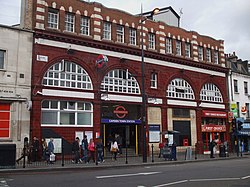 | 22 June 1907 | Edgware, High Barnet, Charing Cross and Bank branches[c] | The junctions connecting the two northern branches of the Northern line to the two central branches are just south of Camden Town station. The station has a pair of platforms on each of the two northern branches, and southbound trains can depart toward either Charing Cross or Bank from either of the two southbound platforms without crossing over.map 21 |
| Station | Image | Opened | Additional information |
|---|---|---|---|
| Mornington Crescent |  | 22 June 1907 | Was planned to be named "Seymour Street", but this was changed. It was closed on 23 October 1992 to replace the lifts and was reopened on 27 April 1998.map 22 |
Euston (Charing Cross branch)  |  | Change for southbound Northern line service via Bank from platform 6,Victoria line,Lioness line andNational Rail servicesmap 23 | |
| Warren Street | 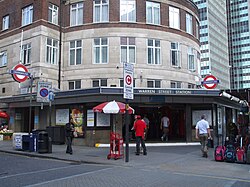 | Change forVictoria linemap 24 | |
| Goodge Street | 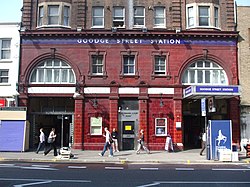 | Opened as "Tottenham Court Road"; renamed 3 September 1908map 25 | |
Tottenham Court Road  |  | Change forCentral line andElizabeth line. | |
| Leicester Square | 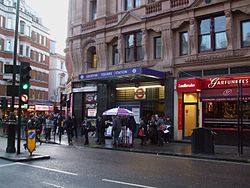 | Piccadilly line opened 15 December 1906map 27 | |
Charing Cross |  | Bakerloo line opened as Trafalgar Square 10 March 1906. Stations combined 1 May 1979. Change for Bakerloo line and National Rail servicesmap 28 | |
| Embankment ( |  | 6 April 1914 | District Railway opened 30 May 1870. Northern line extension from Charing Cross opened 6 April 1914. Extension from Kennington opened 13 September 1926. Change forBakerloo,Circle andDistrict linesmap 29 |
Waterloo ( ( |  | 13 September 1926 | Waterloo and City line opened 8 August 1898. Extension from Kennington opened 13 September 1926. Change forBakerloo,Jubilee andWaterloo & City lines and National Rail servicesmap 30 |
| Station | Image | Opened | Additional information |
|---|---|---|---|
Euston (Bank branch)  |  | 12 May 1907 | Change for southbound Northern line service via Charing Cross from platform 2,Victoria line,Lioness line andNational Rail servicesmap 23 |
King's Cross St Pancras   |  | Metropolitan Railway station opened 10 January 1863. Change forCircle,Hammersmith & City,Metropolitan,Piccadilly andVictoria lines, National Rail services andEurostarmap 31 | |
| Angel |  | 17 November 1901 | Has the longest escalator on the entire Underground networkmap 32 |
Old Street |  | Northern line platforms opened February 1904. Connects with National Rail services.map 33 | |
Moorgate  |  | 25 February 1900 | Metropolitan Railway station opened 23 December 1865. Change forCircle,Hammersmith & City andMetropolitan lines and National Rail services.map 34 Has an interchange with the Elizabeth line viaLiverpool Street station. |
Bank  |  | Linked with Monument by escalator 18 September 1933, change forCentral,Circle,District andWaterloo & City lines andDocklands Light Railway.map 35 | |
London Bridge   ( ( |  | Change forJubilee line and National Rail servicesmap 36 | |
| Borough | 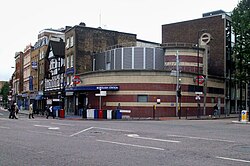 | 18 December 1890 | map 37 |
Elephant & Castle  |  | Change forBakerloo line and National Rail servicesmap 38 |
| Station | Image | Opened | Branch | Additional information |
|---|---|---|---|---|
| Kennington | 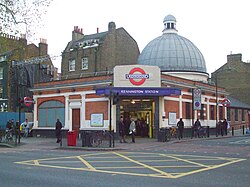 | 18 December 1890 | Charing Cross, Bank, Battersea and Morden branches[d] | The station has four platforms arranged in two pairs: one pair for northbound services to each central branch of the Northern line, the other pair for southbound services from each central branch. The junctions connecting the central branches to the southern branches are just south of Kennington station. Southbound trains from the Charing Cross branch can terminate at this station, which has areversing loop, or join either southern branch; southbound trains from the Bank branch can proceed onto the Morden branch but not the Battersea branch.map 39 |
| Station | Image | Opened | Additional information |
|---|---|---|---|
Nine Elms |  | 20 September 2021 | |
Battersea Power Station |  | Terminus |
| Station | Image | Opened | Additional information |
|---|---|---|---|
| Oval |  | 18 December 1890 | map 40 |
| Stockwell | 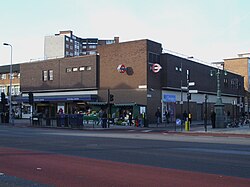 | Change forVictoria line. Original terminus until 1900, when the line was extended to Clapham Common. The station platforms were resited south of the original island platform. Formerly a depot existed here; it was branched off from the current southbound track. It is one of the eight stations that have a deep level air-raid shelter.map 41 | |
| Clapham North |  | 3 June 1900 | One of the two remaining stations to have an island platform underground. It is also one of the eight stations that have a deep level air-raid shelter.map 42 |
| Clapham Common |  | Terminus from 1900 to 1926. It is also one of the two remaining stations to have an island platform underground. It is also one of the eight stations that have a deep level air-raid shelter.map 43 | |
| Clapham South |  | 13 September 1926 | One of the eight stations that have a deep level air-raid shelter.map 44 |
Balham |  | 6 December 1926 | Change for National Rail servicesmap 45 |
| Tooting Bec |  | 13 September 1926 | Opened as "Trinity Road"; renamed 1 October 1950map 46 |
| Tooting Broadway |  | Used as a terminus for some trains heading southmap 47 | |
| Colliers Wood |  | map 48 | |
| South Wimbledon |  | Opened as "South Wimbledon (Merton)". The suffix gradually fell out of use, but still can be seen on some platform signage.map 49 | |
Morden |  | Terminusmap 50 |

When the line opened, it was served by1906 Stock. This was replaced byStandard stock which was in turn replaced by1938 stock as part of the New Works Programme, later supplemented with identical1949 Stock. When thePiccadilly line was extended toHeathrow Airport in the 1970s, its1959 Stock and1956 Stock (prototypes of the 1959 Stock) trains were transferred to the Northern line. As there were not enough 1956 and 1959 Stock trains to replace the Northern line's 1938 Stock fleet, they were supplemented with newly built1972 Mark 1 Stock trains, which all served the line at the same time. 1972 Mark 2 stock trains also ran on this line until going to theJubilee line; they were then moved to theBakerloo line, where they remain in service. By 1986, increasing unreliability of 1959 stock trains meant there were regularly too few trains to run a full peak service. Five 1938 stock trains, newly retired from the Bakerloo Line, were overhauled and returned to the Northern Line to serve another two years until further 1972 stock could be transferred from the Jubilee Line, which was moving to1983 stock. The few 1956 Stock trains were briefly replaced by1962 Stock transferred from theCentral line in 1995, before the entire Northern line fleet was replaced with1995 Stock between 1998 and 2000.
Today, all Northern line trains consist of 1995 Stock in the Underground livery of red, white and blue. In common with the other deep-level lines, the trains are the smaller of the twoloading gauges used on the system. 1995 stock has automated announcements and quick-close doors.[citation needed] If theproposed split of the line takes place (initial estimates of 2018 having been abandoned to focus on completion of the Battersea and Nine Elms extension work), 19 new trains will be added to the existing fleet of 106 trains,[64] though additional trains beyond the extra 19 trains may be required to provide a full service for the new Battersea extension.
Although two other London Underground lines operate fully underground, the Northern line is unusual in that it is a deep-level tube line that serves the outer suburbs of South London yet there is only one station above ground (Morden tube station) while the rest of this part of the line is deep below ground. The short section to Morden depot is also above ground. This is partly because its southern extension into the outer suburbs was not done by taking over an existing surface line as was generally the case with routes such as theCentral,Jubilee andPiccadilly lines. Apart from the core central underground tunnels, part of the section betweenHendon andColindale is also underground. As bicycles are not allowed in tunnel sections (even if no station is in that section) as they would hinder evacuation, they are limited to High Barnet – East Finchley, the Mill Hill East branch, Edgware – Colindale and Hendon Central – Golders Green.[65] There are also time-based restrictions for the sections where bicycles are allowed.[65]
The tunnel from Morden to East Finchley via Bank, 17 miles 528 yards (27.841 km),[1] was for a time the longest rail tunnel in the world. Other tunnels, including theChannel Tunnel that links the UK and France, are now longer.
The Northern line is serviced by four depots. The main one is atGolders Greenmap 51, adjacent to Golders Green tube station, while the second, atMorden,map 52 is south of Morden tube station and is the larger of the two. The other two are at Edgware and Highgate. The Highgate depot is on the former LNER branch to Alexandra Palace. There was originally a depot at Stockwell, but this closed in 1915. There are sidings at High Barnet for stabling trains overnight.
Since the 2000s, TfL has aspired to split the Northern line into two routes.[66][67] Running trains between all combinations of branches and the two central sections, as at present, means only 24 trains an hour can run through each of the central sections at peak times, because merging trains have to wait for each other at the junctions atCamden Town andKennington.[68] Completely segregating the routes could allow 36 trains an hour on all parts of the line, increasing capacity by around 25%.[66][68]
TfL has already separated the Charing Cross and Bank branches during off-peak periods; however, four trains per hour still run to and from Morden via Charing Cross in the peak; the northern branches to Edgware and High Barnet cannot be separated until Camden Town station is upgraded to cope with the numbers of passengers changing trains.[69] The extension to Battersea would allow theCharing Cross branch to terminate at Battersea Power Station.[70][71]
The proposed split of the Northern line would require Camden Town station to be expanded and upgraded, as the station is already severely overcrowded at weekend peak times, and a split would increase the number of passengers wishing to change trains at the station.[71][72][69] In 2005, London Underground failed to secure planning permission for a comprehensive upgrade plan for Camden Town tube station that would have involved demolition of the existing station entrance and several other surface-level buildings, all within aconservation area.[73][74] New redevelopment plans were first announced in 2013 by TfL, which proposed avoiding the existing station entrance and the conservation area by building a second entrance and interchange tunnels to the north, mostly on the site of a subsequently vacatedinfant school.[72] In 2018, plans to upgrade and rebuild Camden Town station were placed indefinitely on hold, due to TfL's financial situation.[75] As of 2024[update], TfL said they still "aspire" to split the line. A partial separation was proposed in which all trains from Morden would operate via Bank, while those starting at Kennington (or Battersea) would serve the Charing Cross branch. The High Barnet and Edgware branches would remain served by trains from both routes.[76]
In October 2003, a train derailed atCamden Town.[77] Although no one was hurt, points, signals and carriages were damaged. Concern was raised about the safety of the Tube, given the derailment atChancery Lane earlier in 2003.[78] A joint report by the Underground and its maintenance contractorTube Lines concluded that poortrack geometry was the main cause, and therefore extra friction arising out of striations (scratches) on a newly installed set of points had allowed the leading wheel of the last carriage to climb the rail and derail. The track geometry at the derailment site is a very tight bend and tight tunnel bore, which precludes the normal solution for this sort of geometry of canting the track by raising the height of one rail relative to the other.[79]
In August 2010, a defectiverail grinding train caused disruption on the Charing Cross branch, after it travelled four miles in 13 minutes without a driver. The train was being towed to the depot after becoming faulty. AtArchway station, the defective train became detached and ran driverless until coming to a stop at an incline nearWarren Street station. This caused morning rush-hour services to be suspended on this branch. All passenger trains were diverted via the Bank branch, with several not stopping at stations until they were safely on the Bank branch.[80][81]
{{citation}}: CS1 maint: numeric names: authors list (link)A segregation of services would deliver simpler service patterns on the line. This will allow more trains to be run through both the West End and City branches – enabling 30tph services on the central London branches. This will provide roughly 25 per cent extra capacity and crowding relief on these busy sections. With the core infrastructure being capable of supporting these service patterns, the main requirements are some additional trains (and stabling) and station capacity improvements at Camden Town.